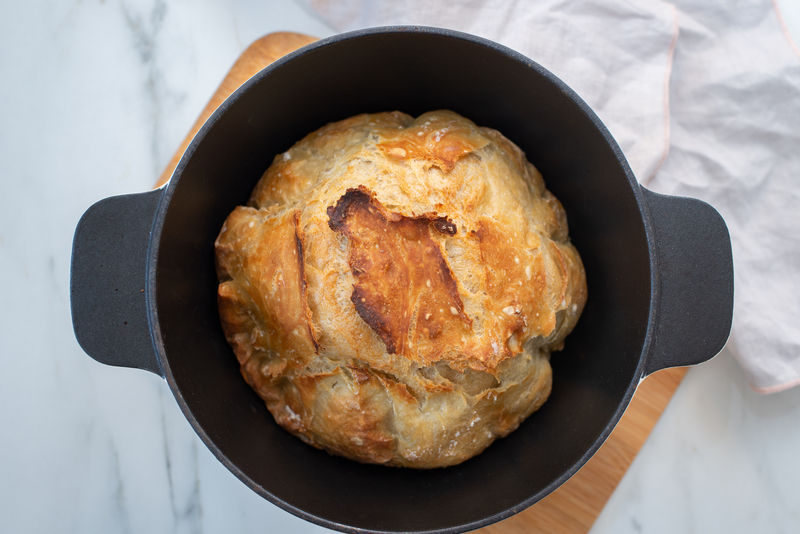 When it comes to baking delicious artisanal bread at home, many factors contribute to achieving that perfect crust and crumb.
When it comes to baking delicious artisanal bread at home, many factors contribute to achieving that perfect crust and crumb.
One of the most debated aspects of bread baking involves whether or not to oil your Dutch oven.
In this article, we’ll explore the pros and cons of oiling your Dutch oven for bread baking and help you make an informed decision for your next baking adventure.
The Role of the Dutch Oven in Bread Baking
Before delving into the oiling dilemma, it’s essential to understand why a Dutch oven is a popular tool for baking bread.
A Dutch oven is a heavy, lidded pot that’s typically made of cast iron or enameled cast iron.
It’s known for its ability to trap steam, creating the ideal environment for achieving a crispy crust and a well-risen, tender crumb in your bread.
The Traditional Bread-Baking Heritage of Dutch Ovens
 Traditionally, Dutch ovens have been used for a wide range of cooking methods, including baking.
Traditionally, Dutch ovens have been used for a wide range of cooking methods, including baking.
The cast iron or enameled cast iron material and the tight-fitting lid make Dutch ovens excellent for trapping steam, which is crucial for achieving a desirable crust and crumb in bread.
However, the decision to oil the Dutch oven before placing the bread dough inside is a relatively modern twist in the bread-baking process.
In the past, Dutch ovens were often seasoned with oil over time through regular use.
This natural seasoning created a non-stick surface and contributed to the unique flavor and texture of bread baked in these pots.
Bakers would rely on the well-seasoned Dutch oven to prevent sticking and ensure a perfectly baked loaf.
As times have changed, and with the advent of modern cooking techniques and materials, the question of whether to oil a Dutch oven for bread baking has become a matter of personal preference and convenience.
To make an informed decision, it’s essential to weigh the historical practices against contemporary approaches, considering how they impact the quality and characteristics of your homemade bread.
Pros of Oiling Your Dutch Oven
- Prevents Sticking
One of the most significant advantages of oiling your Dutch oven before baking bread is that it helps prevent the dough from sticking to the pot.
Bread dough can be sticky, especially when it’s high in hydration, and without oiling, it might cling to the sides or bottom of the Dutch oven, leading to a less than desirable result.
- Easier Cleanup
A well-oiled Dutch oven is much easier to clean after baking.
Since bread dough can sometimes bake onto the pot’s surface, having a layer of oil acts as a barrier, making it simpler to remove any residue once your bread is done.
- Adds Flavor and Texture
Oiling your Dutch oven can also impart a subtle flavor and texture to your bread.
As the bread bakes, some of the oil may be absorbed, enhancing the overall taste and mouthfeel of the crust.
Cons of Oiling Your Dutch Oven

- Altered Crust Texture
While oiling your Dutch oven can contribute to a crispy crust, it can also change the texture.
Some bakers prefer a dry, crackling crust, which may be compromised by the presence of oil.
If you’re aiming for a traditional, rustic appearance and texture, you might want to skip the oil.
- Smoke and Odor
If you use a high smoke point oil like vegetable oil or canola oil, you’re less likely to encounter issues with smoke or undesirable odors.
However, some oils, such as olive oil or butter, have lower smoke points and may produce smoke during baking, potentially affecting the taste of your bread.
- Experimentation Required
The decision to oil your Dutch oven or not largely depends on your personal preferences and the specific bread recipe you’re following.
Different bread types and recipes may benefit from varying approaches, so be prepared to experiment and find what works best for you.
Alternatives to Oiling Your Dutch Oven
If you’re hesitant to oil your Dutch oven but still want to achieve a beautiful crust, consider these alternatives:
- Parchment Paper
Lining your Dutch oven with parchment paper before placing the dough inside can help prevent sticking and simplify cleanup without introducing oil into the equation.
- Flour or Cornmeal
Dusting the inside of your Dutch oven with flour or cornmeal can create a non-stick surface for your bread while adding a rustic texture to the crust.
- Preheating
Preheating your Dutch oven thoroughly before placing the dough inside can also help prevent sticking, as the initial burst of heat helps set the crust before the dough has a chance to adhere.
Bottom Line – Should I Oil My Dutch Oven for Bread?
 Whether you should oil your Dutch oven for bread baking ultimately depends on your preferences and the specific recipe you’re using.
Whether you should oil your Dutch oven for bread baking ultimately depends on your preferences and the specific recipe you’re using.
Oiling can help prevent sticking, ease cleanup, and add subtle flavor and texture to your bread.
However, it may alter the crust’s texture and potentially introduce unwanted smoke or odors.
Experiment with different methods, and consider alternatives like parchment paper or flour to achieve the perfect crust and crumb for your homemade bread.
Remember that the joy of baking is not only in the delicious results but also in the process of discovery and personalization.


